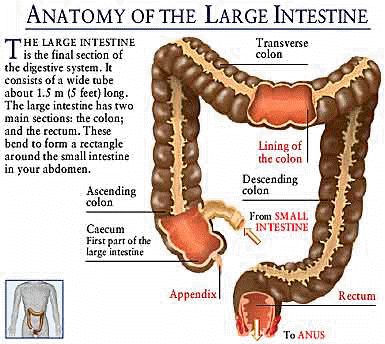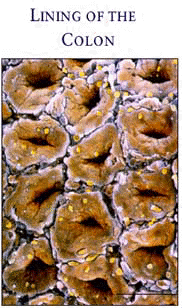

The Astringent Quality
of Point Baihui Du-20 by Shmuel Halevi Ph.D |
The following is a case history of a 38 year old woman who had suffered for four years from ulcerative colitis. The use of point Baihui DU-20, in her case, brought about a full recovery of all symptoms associated with this disease. It is quite rare in acupuncture therapy to achieve a full recovery, especially from a stubborn and hard-to-cure disease, by the use of a mere point in a prescription. However, in this case I had no doubt (nor did the patient) that the use of this point was the turning point of the treatment.
Mrs. H, aged 38, was diagnosed four years prior to her visit to my clinic as having ulcerative colitis. Two years before the diagnosis was established, she started suffering from frequent bowel movements accompanied by heavy bleeding, pus and pain. She was sent to Nahariya Hospital where she had several tests, and where, after two years, was given this diagnosis.
Ulcerative colitis is a chronic, non-specific, inflammatory and ulcerative disease of the colon, characterized most often by bloody diarrhea. The disease usually begins in the rectosigmoid area and may extend proximally, eventually involving the entire colon, or it may attack most of the large bowel at once. Most often an attack begins insidiously with an increased urgency to defecate, mild lower abdominal cramps, and the appearance of blood and pus in the stools.


According to TCM the large intestine is a Fu organ belonging to the digestive system, and its function is mainly to transport the residues of the digested food to the anus for excretion. Its work is dependent mostly on the spleen, which is the Zang responsible for the Yun Hua activity of the digestive system, i.e. transformation and transportation of solid and fluid food.
Diseases of the large intestine may be of internal or external origin. They may be caused by internal imbalances of the digestive system such as ST-Qi or SP-Yang Xu, or by LIV-Qi interfering with the Spleen's activities by 'invasion'. These diseases may involve many different digestive problems, besides that of the large intestine. External inflicted diseases of the large intestine are bound to happen due to the fact that this organ is a Fu, a 'hollow' organ which is in close relation with possible external pathogens e.g. food, water, poison etc. External diseases of the large intestine have a more sudden onset, and usually most of the main symptoms are related to the pathology of this organ itself. Still, by virtue of the large intestine's functional relationship to the Spleen and Stomach, a long enough duration of a large intestine disease may harm the transportation-transformation activities of the Spleen. It may also involve the Spleen's function of 'holding the blood', or even the Spleen's function of 'holding the organs and tissues' in place. In these cases there might be chronic bleeding, hemorrhoids, rectal prolapse and other diseases.
Among the symptoms that Mrs. H. exhibited were the following: cramps and pain in her lower abdomen, belching and flatulence, heartburn, dry and itchy eyes. She would sometimes feel weak and dizzy, but most of the time she felt energetic and strong. She also suffered, lately, from sacral-region pain. She did not have gynecological problems, her periods came on time, and each one lasted 5 days. Mrs. H. had been pregnant four times. She had three children and one artificial abortion.
Physical examination revealed a slim, energetic woman, somewhat nervous, who spoke quickly. Her pulse was rapid (96 on first examination), deep, thin and soggy. In the right Guan position it had a wiry quality as well, and felt more elevated. The tongue was basically pale with somewhat redder edges, covered with slippery yellowish moss.
On palpation of the abdomen I found the descending colon very tender, as well as the epigastric region. The Front-Mu point of the Kidney (Jingmen GB-25) on the left side was also tender, as well as both Front-Mu points of the Liver (Qimen LIV-14).
In accordance with the findings described above, the diagnosis was a Damp Heat invasion of the Large Intestine. The Heat caused the bleeding and the irritation of the inner mucosa of the colon, which in turn caused the frequent peristalsis and the diarrhea. The long duration of bleeding caused a depletion of blood and yin which showed itself in the heartburn, dry eyes and dizziness, as well as the pale tongue and thin submerged pulse. The abundance of Damp showed itself by the slippery yellowish moss.
The treatment was constructed of two phases:
The points were:
Hegu L.I.-4 is the Yuan point of the large intestine. Yuan points deal directly with their associated organs. This point was reduced by rotation and lifting and thrusting manipulation. Dachangshu BL-25 and Tianshu ST-25 were chosen in accordance with the principle of combining Front-Mu and Back-Shu points - to regulate the function of the large Intestine. Shangjuxu ST-37 is the lower He-Sea point of the large intestine and was reduced in order to clear Damp and Heat from that organ. Yinlingquan SP-9 and Sanyinjiao SP-6 are famous for their mutual ability to clear Damp from the digestive system, and hence treat diarrhea and pus in the stools. Zusanli ST-36 was chosen to strengthen the spleen in order to stop the bleeding, and help recreate yin and blood. It was the only point which was tonified. Zhongwan REN-12 is the confluent point of all the Fu and was manipulated evenly. After a course of 12 treatments, 3-4 times a week, the bowel frequency was greatly diminished, from 15 to 20 times a day to 3 to 4 times. There was much less gas and pain in the bowels, and there was very little pus. However, there was only a small decrease of bleeding, which was still apparent. In order to put a further emphasis on arresting the bleeding, the prescription was changed to the following:
Yinbai SP-1 is effective to strengthen the SP and arrest bleeding (by direct moxibustion). Geshu BL-17 the Hui point of blood was tonified. Pishu BL-20 the Back-Shu point of the spleen was tonified to strengthen the spleen function of retaining the blood. Guanyuanshu BL-24 was treated by warming needle technique; this point in concert with Qihai REN-6 arrests bleeding. Tianshu ST-25 was also treated by warming needle technique. Zusanli ST-36 and Yinlingquan SP-9 remained intact.
The use of warm-needle technique was decided upon for two reasons:
This new formula showed itself effective, and after each treatment with moxa, there was a remission of bleeding for one to three days. Along with this the other symptoms further improved, the coating of the tongue subsided, and the bleeding was much less massive.
This new treatment pattern was carried on for about 1 5 sessions. At the end of this course the patient had 1-2 daily bowel movements. Most of the previous symptoms were gone except for bleeding in the stools, and slight light-headedness now And then.
At this stage I decided to further change the point prescription, as follows:
This program was carried on for several weeks, twice a week, but the bleeding still persisted. It is interesting to note that several attempts were made to give the treatment without the burning of moxa on Tianshu ST-25, after which the usual two-day remission in the bleeding did not occur.
At that point I decided (mainly by intuition, I suppose) to add Baihui DU-20 to the prescription. Baihui (Hundred meetings') is a 'cross-road' point on the vertex, belonging to the Du Mai channel. It is the meeting point of all the yang channels, and is situated on the most yang part of the body. It has the function of strengthening yang and elevating Qi. It is also known to raise the sinking Qi of the spleen. In accordance with these qualities (among other qualities not discussed here) this point is largely used for astringent purposes. Astringent purposes in TCM are disorders in which body fluids like urine, diarrhea, sweat, blood etc. are discharged abnormally, and/or organs (uterus, rectum etc.) slip, or sink, from their normal positions. I therefore punctured Baihui DU-20 in a horizontal manner, 1 cun deep, in a posterior direction. The patient felt rather a strong tingling sensation all over the top of her head, along with local pain and distention. From that treatment on there was no recurrence of bleeding in the stools. The patient carne to me thereafter for several months, once a month, to receive the same treatment, and her condition remains unchanged.
The cessation of bleeding and restoration of complete normal functioning of the large bowel was indeed dramatic after the application of point Baihui. The gradual improvement of the patient's condition i.e. elimination of Shi symptoms first, and then restoration of normal bowel functioning, proves that basically both the diagnosis and treatment were applied correctly.
However one might wonder whether an earlier application of Baihui would have cured the patient earlier. Still the main conclusion, in my opinion, is twofold:
![]() Link
to Dr. Halevi's homepage.
Link
to Dr. Halevi's homepage.